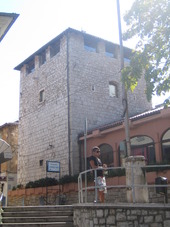to enlarge


or choose the place
from the menu below
 Rome |
 Byzantium |
 Venice |
 Vienna |
 Brioni |
 Smrikve |
 |
 |
From Laurana you can walk along the sea all the way to Opatija, and this is one of the prettiest walks in Istria and some people say in the World.
Lovran is a very old town. Like many other Istrian towns and villages, also Lovran was a prehistoric hill fort settlement. It is mentioned for the first time by Marcomirus in the 7th century as Lauriana.
Romans used to call it Laurentum due to laurel plant that grows in Lovran. Laurel plant is “lauro” in Italian and “lovor” in Croatian. The various names that Lovran had were: Laurentum, Lauriana and Lauran or Laranne.
It is possible that Roman general Marco Vispanio Agrippa, who married with Emperor Augustus’s daughter Giulia, established a summer residency in Lovran and was among the founders of the Roman Laurentum.
A part of being famous for the laurel plant, Lovran is also famous, since the 16th century, for the chestnuts. Chestnuts has remained important for Lovran until today and every year in autumn (“Lovranski maruni”) are part of the local cuisine. There is also a very nice festival organized every year.
After the Roman Empire dissolution and barbarian invasions Lovran became part of Byzantine Empire and Carolingian Kingdom.
In the Middle Ages it has changed several rulers but was for most of the period indirectly under the Austrian government: Pula’s Bishops (1028), Counts of Gorizia (1295), Alberto IV Count of Istria and Pazin (1342), Hapsburg family (1374), Febo della Torre (1447), Hapsburg family (1452). In 1508, Venetians occupied Lovran, and attacked it again in 1599, and also during the war with Uskoci in 1612 and in 1614, but the town remained part of the Austrian dominions in Istria.
There was only a short experience of the Napoleon rule at the beginning of the 19th century and later on, for a century, Lovran was part of the Austro-Hungarian Monarchy.
After the First World War, Lovran, became part of Italy and after the Second World War part of Yugoslavia (Croatia).
During the Italian Fascist period in Istria many Istrian families suffered from the regime or had to leave Istria. Fascism in Istria applied various repressive measures mostly towards Slav populations and this created the Antifascist Movement.
The Second World War was a very painful experience for the Istrian population and many innocent Istrians, both Slav and Latin, died during that war.
After the second World War Lovran became part of Yugoslavia (Croatia). There were three agreements between Yugoslavia and Italy which established that Istria would become a part of Yugoslavia: Paris Agreement of 1947, London Memorandum of 1954 and the Osimo Agreement reached in 1975.
In the first decade after the Second World War many Istrians, especially those living in towns and villages that for centuries were part of the Venice Republic, decided to leave Istria.
In 1991 with the fall of Yugoslavia and the founding of the Republic of Croatia, the internal republic boundaries were recognised as the state boundaries and Lovran is today part of Croatia.
In 2013 Lovran became part of the European Union. You can not change the past but you can try to learn from it. The main aim of the European Union founders was to build a system that could avoid future wars and future refugees in Europe as I explain in COSMOPOLITE.
LOVRAN - VIRTUAL TOUR
 Parts of the medieval fortifications have been preserved in the walls of the houses
that make an oval circle all over the old city. Well preserved are also the town gates Stubica which are
located in front of the sea and in front of the old port. Not far away from this town gate there is a small Church of
St. Trinity, built in the 14th century. It has the typical architecture of the small churches with a porch that you
can find in many places spread all over Istria.
Parts of the medieval fortifications have been preserved in the walls of the houses
that make an oval circle all over the old city. Well preserved are also the town gates Stubica which are
located in front of the sea and in front of the old port. Not far away from this town gate there is a small Church of
St. Trinity, built in the 14th century. It has the typical architecture of the small churches with a porch that you
can find in many places spread all over Istria.
Few hundreds meters from the Stubica town gate there is a larger entrance to the old town that brings you to the main square of the old town. You will pass by the defence tower from the 13th century on your right side.
On the left side you will see the Parish Church of St. George from the 12th century. This church was completely reconstructed in the Gothic style in the 14th century, while the net like grooved vault of the sanctuary was built around 1470. In the 18th century the church was given a Baroque style by an addition of a number of chapels and by the construction of a new façade.